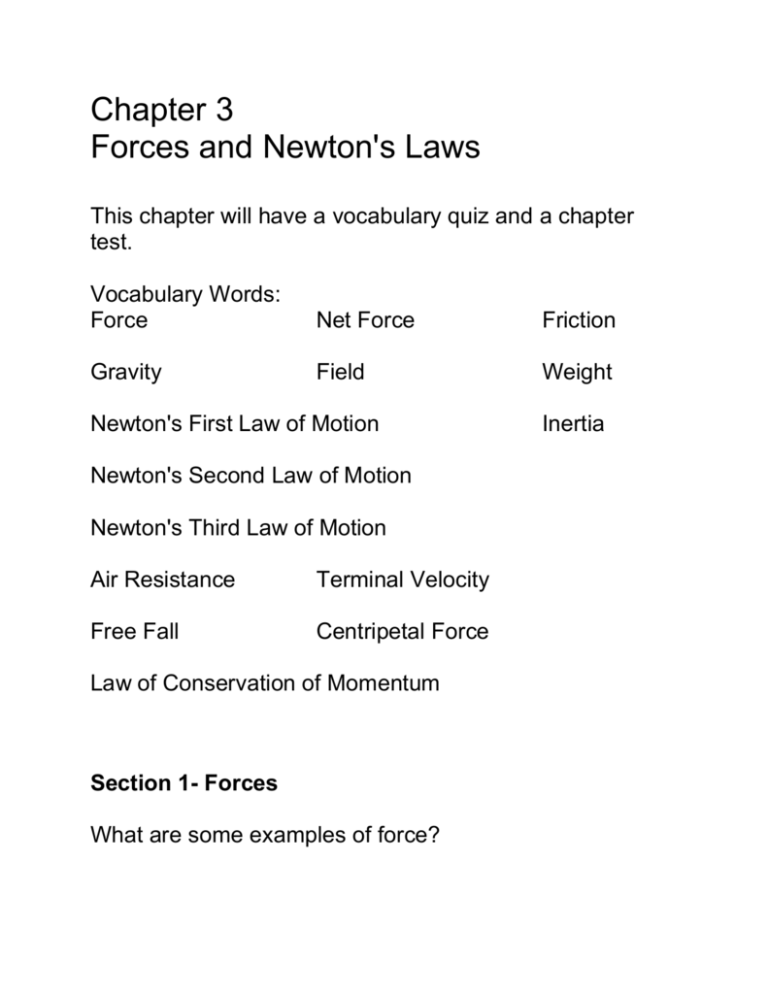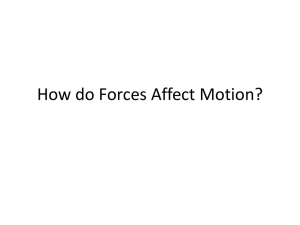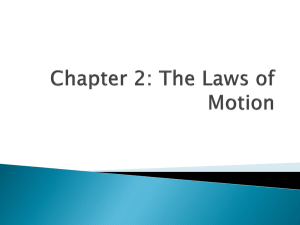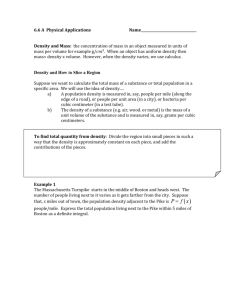Physical-Science
advertisement

Chapter 3 Forces and Newton's Laws This chapter will have a vocabulary quiz and a chapter test. Vocabulary Words: Force Net Force Friction Gravity Field Weight Newton's First Law of Motion Newton's Second Law of Motion Newton's Third Law of Motion Air Resistance Terminal Velocity Free Fall Centripetal Force Law of Conservation of Momentum Section 1- Forces What are some examples of force? Inertia Catching a basketball, hitting a baseball, throwing a football, pushing or pulling a chair...etc... A Force is a push or a pull. In the examples above the force changes the movement of the ball. Here we can see an obvious applied force. Sometimes forces are not as noticeable. For instance, the floor exerts a force on your feet & the atmosphere pushes against your body as gravity pulls on it. Every push, pull, stretch, or bend results in a force being applied to an object. A force can cause the motion of an object to change When a person kicks a soccer ball their foot strikes it with a force that causes the ball to stop and then move in the opposite direction. The velocity of the ball is changed by a force. When two or more forces act on an object at the same time, the forces combine to form the net force. The net force is the sum of all of the forces acting on an object. Forces have a direction, so they follow the same addition rules as displacement -Same direction add -opposite directions subtract -not same or opposite use different equation Forces are measured in the SI unit Newtons (N) Unbalanced Forceswhen forces are acting in the same direction, or when forces in opposite directions have one larger force, the forces are unbalanced and the object the forces are acting on will move. or Net force : Because the net forces do not balance out to equal 0, we call these unbalanced forces. Balanced Forcessuppose that these two forces were acting with the same size force, but in opposite directions. Net force: =0 N The net force on the box would be 0 because the forces cancel each other out. Forces that are equal in size and opposite in direction are called balanced forces. Unbalanced forces cause changes in motion, Balanced forces do not cause changes in motion. HW: Finish the worksheet Friction: If you push a skateboard with your hand, what will happen after you let go? Eventually it will slow down and stop. Because the skateboard's motion changes as it slows down, there must be a force acting on it. The force that slows the skateboard down is called friction Friction is the force that opposes the sliding motion of two surfaces that are touching each other. Friction is caused by the bumps on all surfaces even smooth surfaces, rubbing against each other as force is applied. these small points of contact between the bumps are called microwelds, and are the source of friction. A force must be applied to break the microwelds. Types of Friction: -Static Friction- prevents two surfaces from sliding past each other, due to microwelds that have formed between bottom of object and the floor. the force on the object is not large enough to break the microwelds and the box does not move. -Sliding Friction- opposes the motion of two surfaces sliding past each other, caused by microwelds constantly breaking and forming as the objects slide past each other. Usually smaller than static friction. You are able to apply a force to move the object, but if you stop pushing the object will stop moving. -Rolling Friction- a special case of static friction when friction works over an area where a wheel and the ground re in contact. Wheels need friction with the ground to turn, without it (like on ice) they just spin. this is also called traction when dealing with tires on vehicles. GravityYou exert an attractive force on everything around you, your desk, classmates, even the earth! this attractive force acts on all objects that have mass and is called gravity. Gravity is an attractive force between any two objects that depends on the masses of the objects and the distances between them. Gravity is one of the four basic or fundamental forces. (the other 3 are electromagnetic force, strong nuclear force, and weak nuclear force) Gravity acts on all objects with mass and has an infinite range. According to the law of universal gravitation, the gravitational force between two masses decreases rapidly as the distance between the masses increases. However, no matter how far apart two objects are, the gravitational force between them never completely goes to zero. Because the gravitational force between two objects never disappears, gravity is called a long-range force. Because contact between objects is not required, gravity is sometimes called a field. a field is a region of space that has a physical quantity at every point. All objects are surrounded by a gravitational field. The strength of the gravitational field, g, is measured in newtons per kilogram. Weight- The gravitational force exerted on an object is the object's weight. Scientists use a simplified version of the universal law of gravitation to calculate weight: Weight (N) = Mass (kg) x Gravitational Strength (N/kg) Fg=mg we use Fg because weight is the force due to gravity. Weight is measured in N because it is a force. Weight and Mass are not the same, Weight is a force, Mass is the amount of matter in an object, though they are related. weight increases as mass increases. We most commonly use weights on Earth. Near Earth's surface, g = 9.8 N/kg. this is what we will use for calculations of weight on earth. HW: read p 79, complete #4-10 Newton's Laws of Motion Newton's laws of motion apply to the motion of everyday objects, like cars and bicycles, as well as the motion of planets and stars! Newton's first law of motion Remember: Forces change an object's motion. Newton's first law explains the relationship between force and change in motion: Newton's First Law of Motion states that an object moves at a constant velocity unless an unbalanced force acts on it. This means that a moving object will continue to move in a straight line at a constant speed unless an unbalanced force acts on it. And an object at rest will stay at rest until an unbalanced force acts on it. (simpler terms, An object in motion will stay in motion and an object at rest will stay at rest) Newton's first law as often called the law of inertia. Inertia is the tendency of an object to resist any change in its motion. Inertia is directly related to massThe greater an objects mass is, the greater its inertia is. Will a bowling ball or a ping pong ball have more inertia? Why? Newton's Second Law of Motion Describes how the forces exerted on an object, its mass, and its acceleration are related. The acceleration of an object depends on its mass as well as the force exerted on it. Newton's second law of motion states an object's acceleration is in the same direction as the net force on the object and is equal to the net force exerted on it divided by its mass. OR F=ma Net force (N) = mass (kg) x acceleration (m/s2) Practice problem: What is the net force on a wagon with a mass of 12 kg that is accelerating at 0.5 m/s2? Newton's Third Law of Motion Newton's third law of motion states that when one object exerts a force on a second object, the second object exerts a force on the first that is equal in strength and opposite in direction. OR for every action force there is an equal and opposite reaction force. The forces do not cause one another, but occur at the same time. The forces do not cancel out because they are occurring to different objects: Think of a boat tied to a dock with a rope. You could say the action force is the boat pulling on the rope and the reaction force is the rope pulling on the boat. This law states the important fact that forces are interactions between objects, something is applying a force to something else, the force cannot occur on its own. Even if the two objects have different masses, they will feel the same size force -bug on a windshield . HW: p85 #15-21 In your group, read about your assigned use/function of Newton's laws. You have 25 minutes to become an expert on this. 1- Air Resistance (including size and shape) 2- Speed and Terminal Velocity 3- Free Fall and weightlessness 4- Centripetal forces 5- conservation of momentum After this time we will move into new groups (the color of your card) and you will teach your classmates about your function of Newton's Laws. Make sure you take notes! HW: Review p 92 (22-28)







